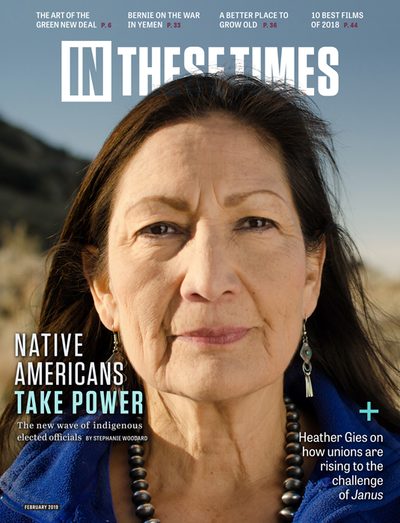Top 10 Strangest (and Most Beautiful) Films of 2018
The best films of the year explore the hollowness of contemporary Korean culture, faith in an era of climate change, the last frantic day in the life of a Hollywood director and more.
Michael Atkinson

This year’s best movies were, broadly speaking, freaks and geeks, weird signals from the outskirts. A black-and-white Mexican mood piece about a domestic worker may win the best picture Oscar, if critical hype retains its momentum — another sign, if we needed one, of movies’ loosening grip on the public mind and heart. (To most non-Americans, American movies appear to consist of expensive quasi-genres — “blockbusters,” “action films,” “reboots” — that didn’t really exist for the medium’s first 80 years.) Like our political system and our policy institutions, movies haven’t quite caught up to where we are, spinning their wheels in old formulas and forms, while technology and its attendant cultural distortions bullet us into the future.
So, we’re talking here about movies that traffic in the margins and target adults like any respectable art form should. It speaks volumes that two of my top 10 films of 2018 are detritus left behind by dead people. But my No. 1, and easily the year’s least-fucks-given journey into painful, serious-issue territory, is Paul Schrader’s First Reformed. In addition to writing the screenplays for many of Martin Scorsese’s best films, Schrader has been making his own movies since the 1970s that probe into ethical, social and spiritual issues (from Hardcore and American Gigolo to Mishima, Patty Hearst and Affliction). First Reformed is his best and most dismaying movie, a character study of a guilt-wracked pastor in a small, upstate New York parish confronting his own lack of faith, his failure as a man and his tortured, evolving response to a parishioner who clearly sees the Armageddon of climate change. Cosmic and gruelingly intimate, it’s not meant to be a breeze to watch, and it’s not.
Alfonso Cuarón’s Roma (No. 2) hardly needs me to sing the praises of its sterling cinematography, or its gentle and nuanced portrait of an unassuming domestic worker (nonprofessional actress Yalitza Aparicio) in a middle-class Mexican family in the throes of divorce; it’s already the most widely praised film of the year. And it’s lovely and wise, and free of cliché, if also a little safe and unchallenging (it holds no candle to Cuarón’s best film, 2006’s Children of Men). Lucrecia Martel’s Zama (No. 3) has less grace but more teeth, a wickedly dry comedy about a Spanish colonial in a South American province in the 1700s who wants to return to Europe but ends up being engulfed by the frontier and the violence of colonialism instead.
Abbas Kiarostami’s 24 Frames (No. 4), released nearly two years after his death, is an ambient contemplation on the act of watching, made up of koan-like, digitally enhanced, four-and-a-half-minute set-piece shots full of animals, wind and hints of violence.
Lee Chang-dong’s Burning (No. 5) adapts Haruki Murakami’s short story “Barn Burning” to explore, in Lee’s uneasy fashion, the hollowness of contemporary Korean culture, in a sneaky tale of deceptions and elisions. Its comic B side, in a way, is Yorgos Lanthimos’ The Favourite (No. 6), a riotous look at the suppurating reign of England’s Queen Anne and the sexually fraught scheming that surrounded her.
Hale County This Morning, This Evening (No. 7) is the year’s underdog — a bewitchingly lyrical documentary about an Alabama town and its mostly black, low-wage citizens, filmed by its own high school basketball coach. Five years in the making, it is self-knowing, beautiful, unpatronizing and lecture-free. In contrast, Adam McKay’s bulldozer Vice (No. 8) is, like McKay’s The Big Short, broadly comic and angrily Chomskian, blaming Dick Cheney (Christian Bale) for virtually everything that’s wrong with the country. Satires with shark teeth are rare these days; Orson Welles’ The Other Side of the Wind (No. 9) qualifies, as an autobio rip on 1970s Hollywood. This cobble-job, assembling 48-year-old footage 33 years after Welles’ death, is a fascinating self-analysis, set on the last frantic day in the life of a Welles-like director (John Huston) facing the new Hollywood.
All of the above will feel more familiar than my No. 10, the bizarre Estonian film November, an inky, black-and-white, 1800s peasant fable centered on a pair of separated lovers, but which is strangely overrun with “kratts” (handmade contraptions given human sentience), lycanthropes, the Black Death and Satan himself. Talk about out of left field.
Runners-up, in order: Thoroughbreds (Cory Finley, U.S.), The Land of Steady Habits (Nicole Holofcener, U.S.), Araby (João Dumans, Affonso Uchoa, Brazil), Cocote (Nelson Carlo de Los Santos Arias, Dominican Republic), The Kindergarten Teacher (Sara Colangelo, U.S.).









